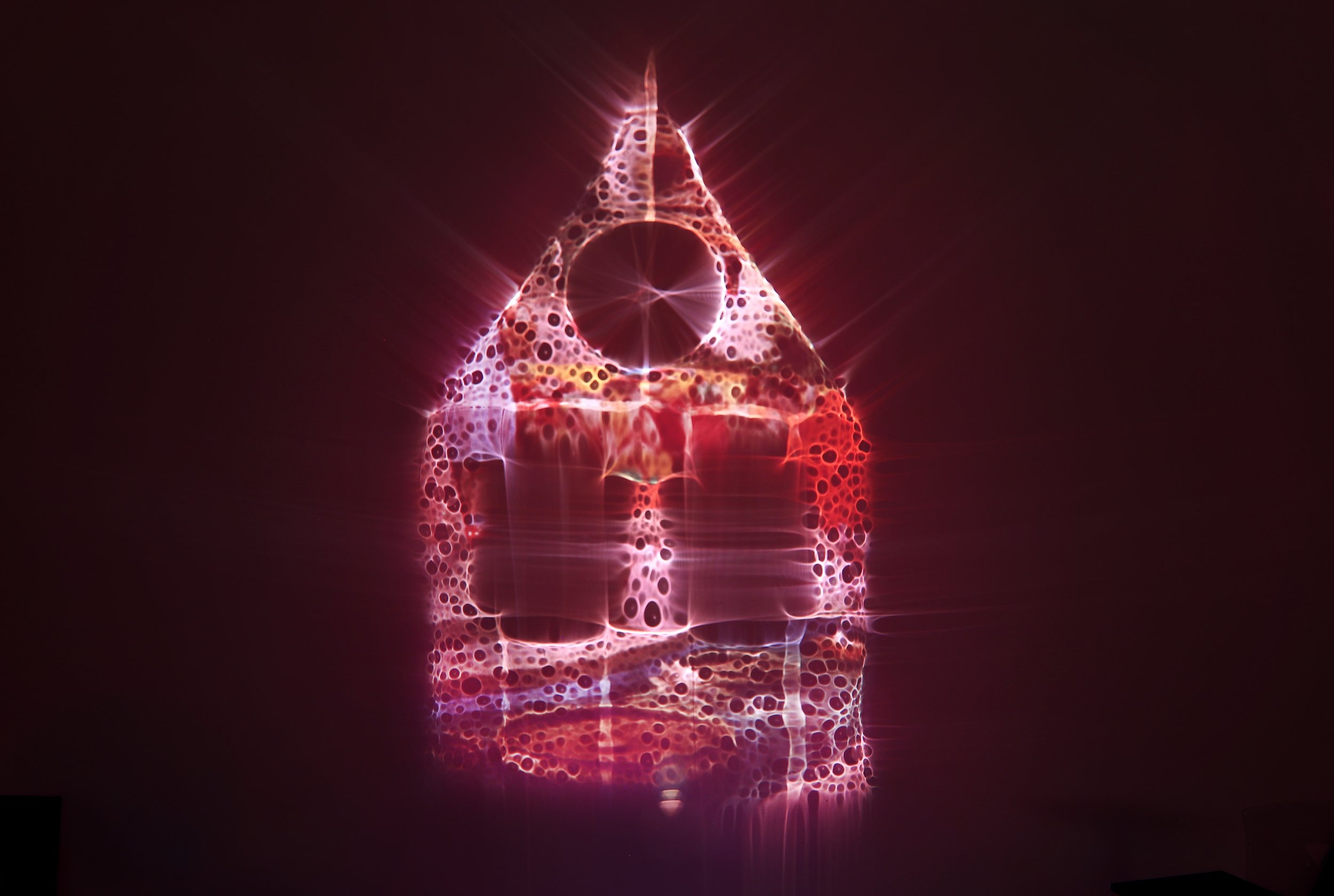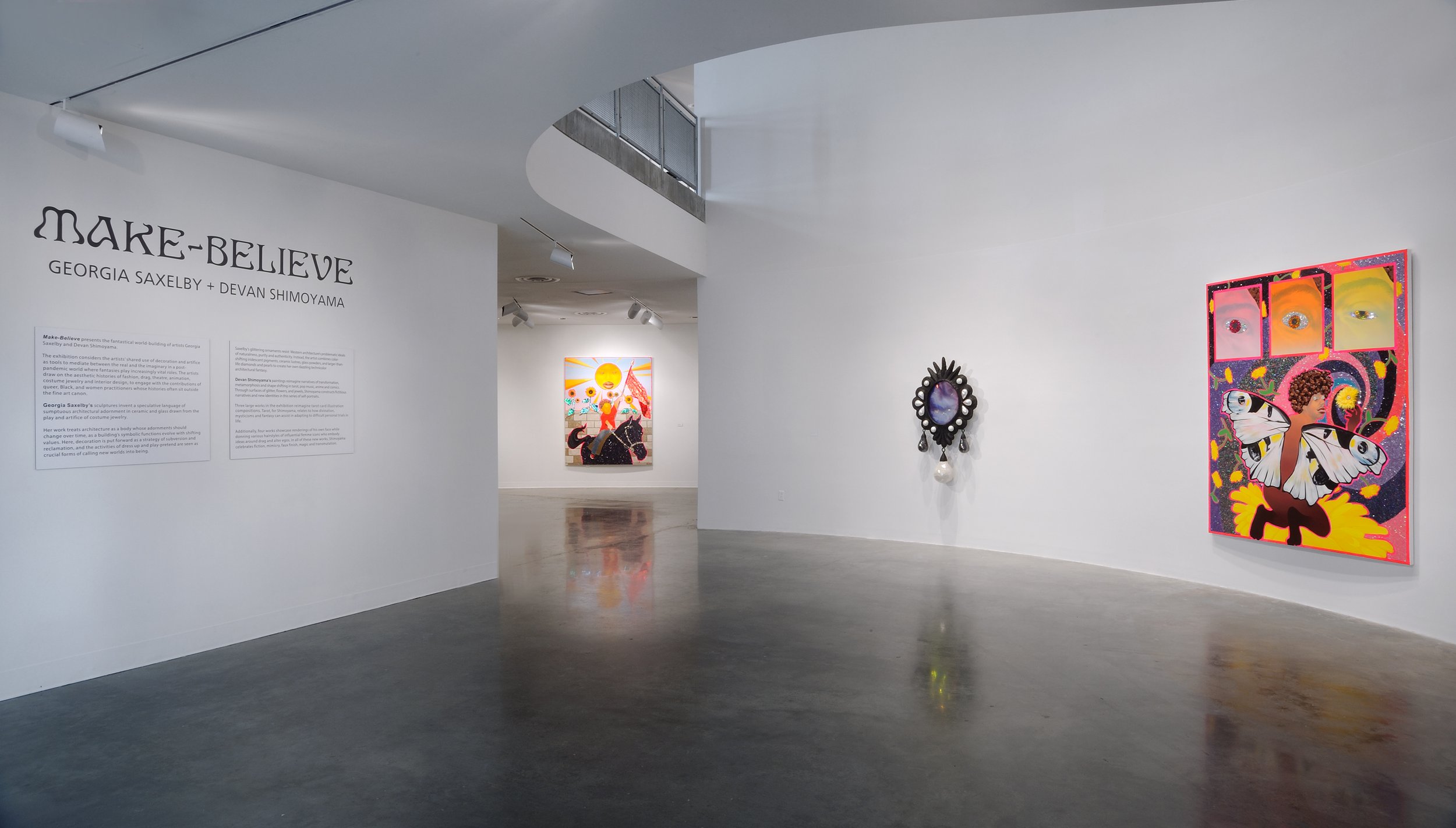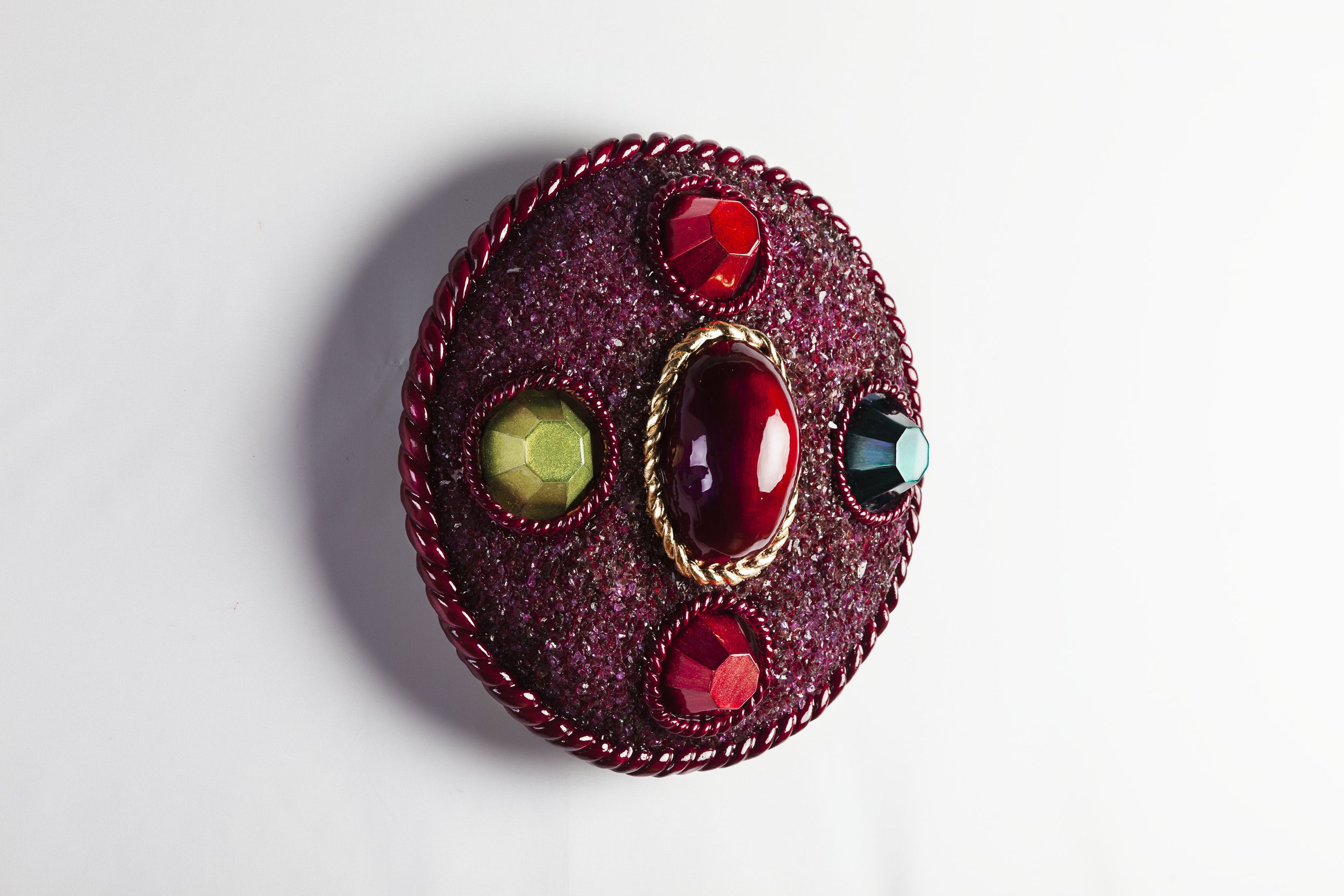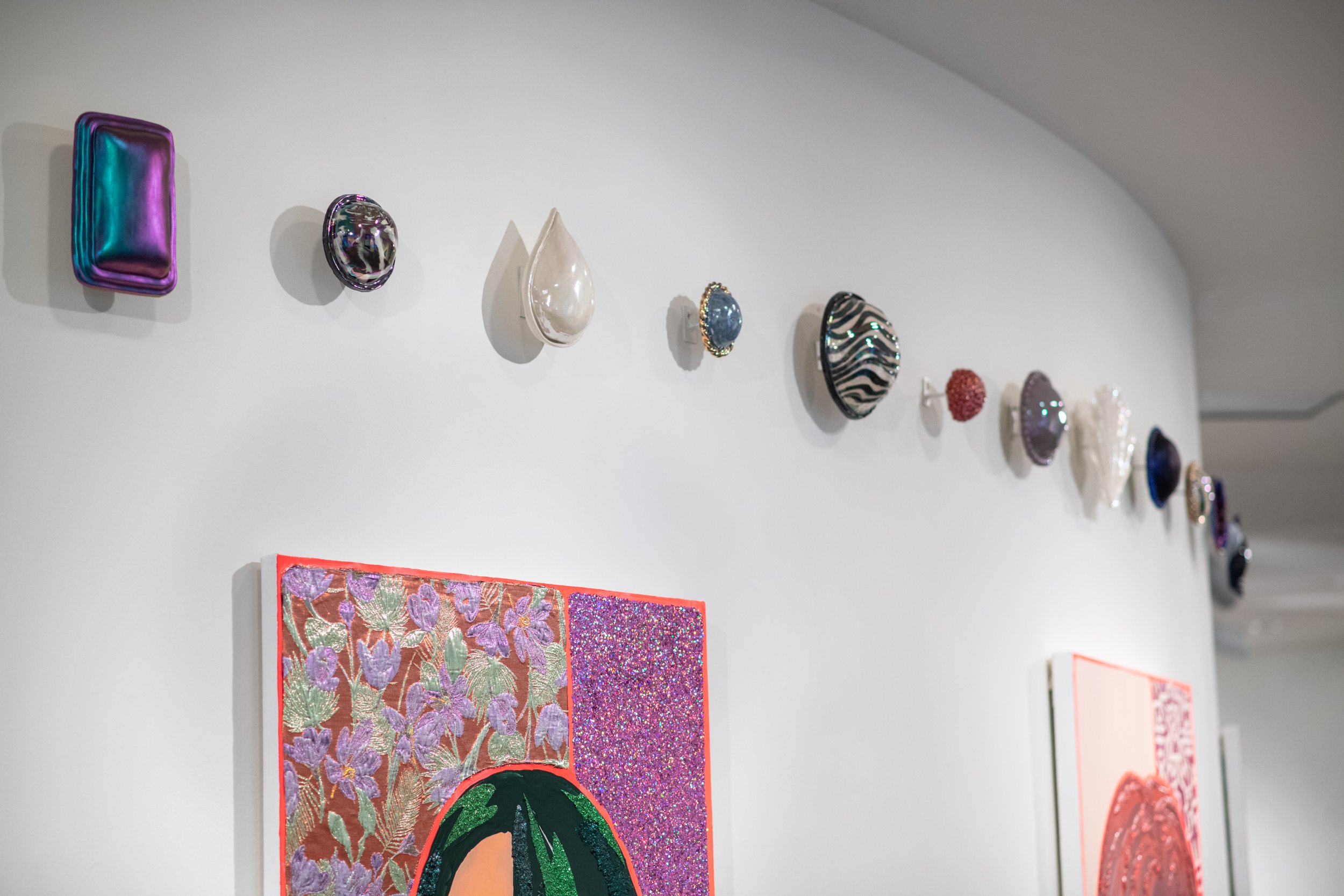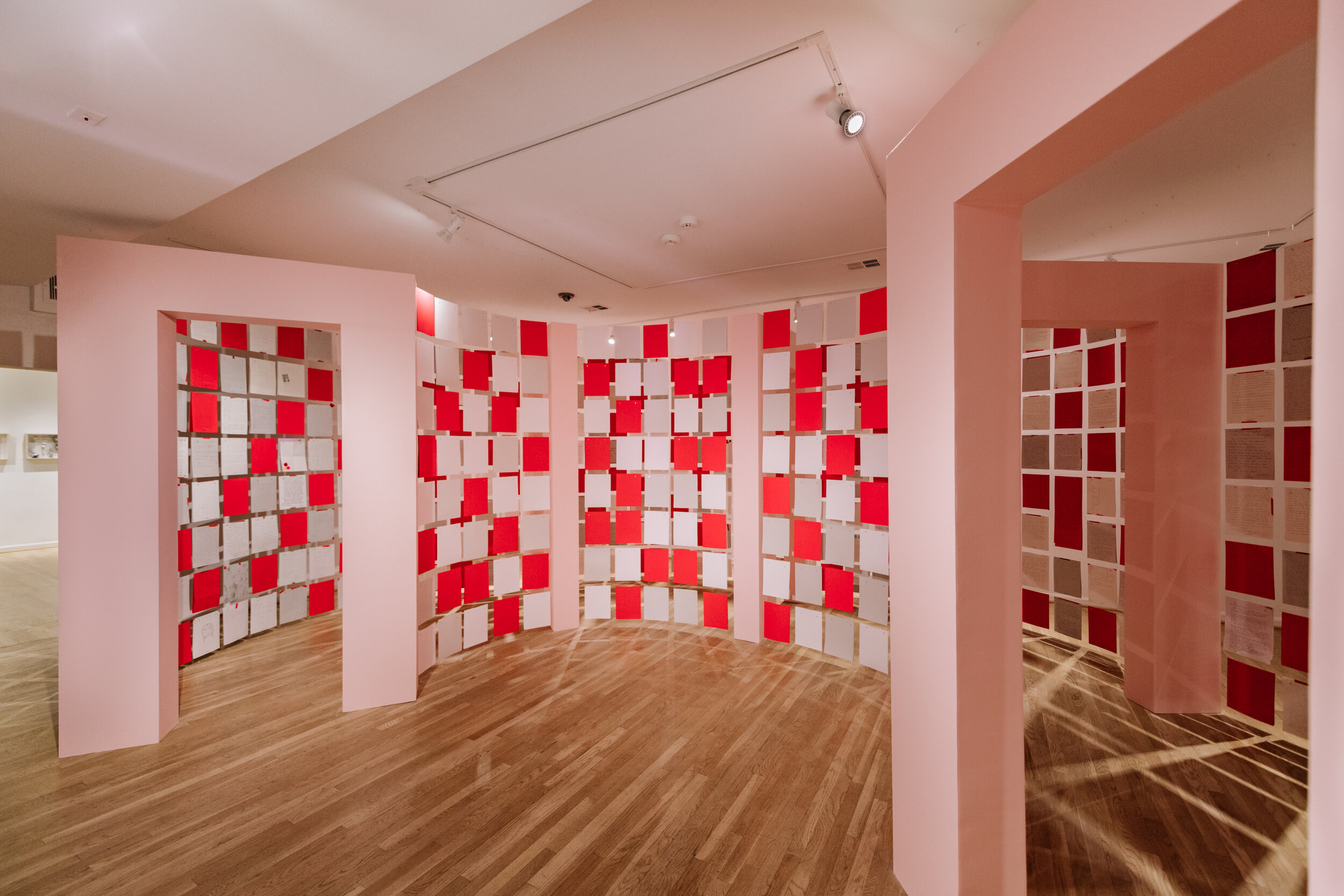Magic Hour
Exhibition: Miller Institute of Contemporary Art, Pittsburgh, USA (2024)
Exhibited in 2024 at the Miller Institute of Contemporary Art, Pittsburgh, Magic Hour comprises a series of glass sculptures that bend, warp and scatter video projections across the museum space. The glass objects fracture moving images into dreamlike chromatic apparitions that crawl across the walls, flicker through apertures, and blur in and out of focus just below the threshold of recognition. The shimmering vertiginous images that result recall the dizzying, saturated light of the artist’s childhood where edges blurred under the intensity of the Australian sun. They also recall the technicolor palette of the Wizard of Oz, a filmic reference throughout the development of this work, with its destabilization of the veils between magic and illusion, reality and dreams. Like a magic mirror or crystal ball, these sculptures have both a material life and an immaterial life. They invite the viewer to see with “second sight,” eluding rational, perspectival ways of looking and becoming devices for navigating psychological space. The sculptures were made by Saxelby using glass powders in the kiln, by pouring molten glass from a ladle, and by stretching blown glass into serpentine forms while she was an Artist in Residence at the Pittsburgh Glass Center in Pennsylvania. Saxelby uses glass to find ways of seeing that resist the certainty of edges, hierarchies, and absolutes. In Magic Hour, form is not a fixed entity, but rather it is a mirage or an afterimage on the underside of one’s eyelids.
Sound: Ollie Brown | Documentation: Tom Little (photo), Max Cianci (video)
Propositions for Architectural Ornaments
Exhibition: Make-Believe with Devan Shimoyama at the Katzen Art Center at the American University Museum, Washington, D.C. (2023)
In Propositions for Architectural Ornaments, Saxelby reimagines the ornaments and decorations that dress Western architectural buildings, from Classical to Victorian facades. Drawing from her grandmother’s costume jewelry collection, Saxelby’s glittering ornaments in ceramic and glass rely on artifice, fantasy and theatricality, resisting Western architecture’s ideals of naturalness, purity and authenticity. The artist combines color-shifting iridescent pigments, ceramic lusters, glass powders, and larger-than-life rhinestones and pearls to create her own dazzling technicolor architectural fantasy. Decoration is put forward as a strategy of subversion and reclamation, and the activities of dress up and play-pretend are seen as crucial forms of calling new worlds into being.
Photo: Shan Turner-Carroll, Kate Warren, Gregory Stanley
Exhibition: The Phillips Collection, Hirshhorn Museum, Smithsonian Arts & Industries Building, Anacostia Art Center, and IA&A at Hillyer, Washington, D.C., 2018
To Future Women (2018, 2037) is a 20 year time capsule of letters written to the next generation of women to memorialize the 2017 Women's March and ongoing #MeToo movement. It is a networked interactive artwork that invites participants - women, men and all gendered identities - around the world to write a letter to women in twenty years time. Part art and part history, this collection of letters will be archived for twenty years in Washington, DC by national museums and re-exhibited in 2037 on the 20th anniversary of the Women’s March. To Future Women uses the platform of art to historicize one of the largest single protests in global history.
To date, To Future Women has received over 3000 letters in 10 different languages, including from Hillary Clinton and Dr Jill Biden, and been covered by press all over the world. The project launched at The Phillips Collection on 21st January, 2018, the one year anniversary of the Women's March, and traveled to different cultural institutions in Washington, DC over the following six months, including the Smithsonian's Hirshhorn Museum & Sculpture Garden, the Anacostia Art Center, the Smithsonian Arts & Industries Building and IA&A at Hillyer.
Photo: Kate Warren, Joe Gibson
Lullaby
Exhibition: Samstag Museum, Adelaide (2020); Embassy of Australia, Washington D.C. (2019) ; Artspace, Sydney (2018)
Lullaby documents a series of performances staged at five of the monuments on Washington’s National Mall. The video work employs a system of invented ritual gestures to present a proposition: can we invent new meanings for old monuments? Can we change the way we relate to imposing architecture by encoding it with new choreography and behavior? Leveraging the Classical propositions of the Greco-Roman derived monuments, the performers mold their bodies into the architectural forms emphasizes the spaces in between the Classical symbolic order. Through mirroring and contorting the architecture in the editing process, Saxelby manipulates the existing structures to create her own virtual architectures, questioning the symbolic spaces in which Western identities and value systems are performed today. Entitled Lullaby, this work reflects Saxelby’s interest in ephemeral and performative systems of transmitting cultural knowledge in contrast to Western architecture’s permanence and rigidity.
Performance/Choreography: Vanessa Soudan | Cinematography: Katie Schuler | Photography: Kristin Adair | Sound: Great Waitress (Laura Altman, Monica Brooks and Magda Mayas)
The Architecture of a Witch's Hut
Exhibition: Artereal Gallery, Sydney (2019); UNSW Galleries, Sydney (2018); Wassaic Project, New York (2017)
The Architecture of a Witch’s Hut (2017) is an interactive installation stemming from the idea that a witch’s home is one of the few typologies of architecture built by a woman for herself. The artist undertook the process of independently building her own structure in seven days - its height determined by how high she could reach on a ladder and its joinery determined by the tools and materials on hand. Created during an artist residency in upstate New York, its form references the site’s surrounding New England architecture and, with it, the real history of witch burning in the area 300 years prior. The project culminated in a collective burning of the structure with fellow artists in residence and the small town’s local community, reclaiming fire from a destructive and violent force to one of memorialisation.
Photo: Subodh Samudre
BREAK
Exhibition: Finalist in the 64th Blake Prize at the Casula Powerhouse, Sydney (2016)
Part installation, part audience-driven performance, BREAK (2016) examines ceremonial acts of catharsis involving the creation and destruction of totemic or sacred objects. The artist created a subversive space that facilitated a ritual performance which allowed for a temporary suspension of normal social behavior – particularly that within an art gallery. BREAK consists of a white wall-mounted grid, a new kind of shrine, housing ceramic figures developed from the artist’s research into the ubiquitous and ancient ceremonial use of dolls. In front sits a plinth that has been transformed into an altar.
With no formal instructions, members of the audience are intuitively invited to select a ritual doll and - standing on a pedestal facing the collective audience - smash it. Raising questions about the way museum objects are thought of as being able to transform the viewer morally or emotionally, BREAK collides the objective, rational, contemporary art spectacle with an audience driven, sacrificial destruction of artworks. A collaboration with a group of three performance artists lead to a series of performances that played the role of opening ceremony and audience instruction.
With guest performances by Machiko Motoi, Elizabeth Hogan and Adam Gottlieb. Photo: Kai Wasikowski
Ritual Gathering
Exhibition: Finalist in the 64th Blake Prize at the Casula Powerhouse, Sydney (2016)
Ritual Gathering (2016) transforms a modern birthday celebration into a powerful symbolic event. The participatory installation disrupts the spatial hierarchies and viewing protocol of an art museum context to antagonize and reimagine the conventional language of art. The work sought to highlight the audience’s intuitive, triggered response to a deeply ingrained ritual process by presenting them with specifically arranged motifs to which they had to respond with no instruction.
The installation’s focus is a large painted cake - a living artwork that is consumed on the exhibition’s Opening Night - created in collaboration with Australia’s most celebrated patissier Adriano Zumbo. Twelve hand-painted birthday hats appear to float at head height under which twelve cushions act as place settings, inviting audience members to sit together and participate. It intended to question the contemporary Western dislocation between art and ritual by challenging the audience’s role within the gallery space.
Edible sculpture in collaboration with patissier Adriano Zumbo. Photo: Kai Wasikowski
